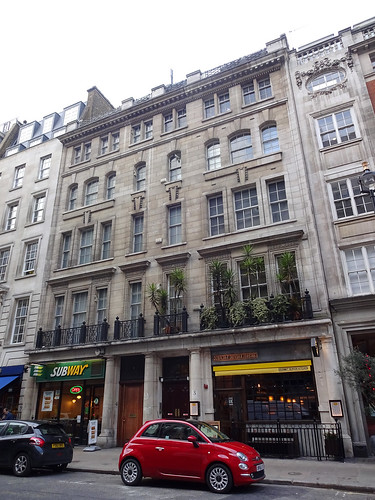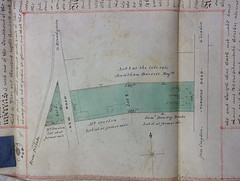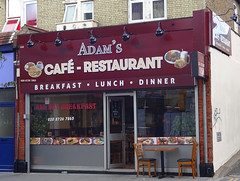As noted in an earlier article, I’m covering the site of 145–151 London Road in a mini-series of four articles. The first of these covered the initial development of the site and the full history of the southernmost property built there, the second discussed the second property going northwards, the third covered the third property, and here I discuss the fourth property plus the present-day occupants of the entire site.
1820s–1880s: Common land becomes private land
The site in question, bounded on the north by Chatfield Road, on the south by Montague Road, and on the east by London Road, was common land until the 1820s, being part of a large area known as Parson’s Mead. Following the 1823 Parson’s Mead Inclosure Act, this plot (and much of the rest of Parson’s Mead) became the property of the Caldcleugh family, who then sold it off in the 1830s.[1]
This particular piece of land was sold at auction in April 1838, divided into two lots. The south side went to Henry Overton, a Croydon-born brewer in his late 40s, while the north side went to Jonathan Barrett, an iron and brass foundryman from Streatham.[2] By the early 1850s, Henry had built and rented out three houses on his land (discussed in my articles on 145, 147, and 149 London Road, respectively).
Jonathan’s land followed a different path. As well as this plot of land, Jonathan had also purchased the house and grounds previously occupied by the Caldcleughs themselves: Broad Green House, a large property immediately to the north of here. He appears to have simply used this strip of land to extend the Broad Green House grounds further southwards, and as such it remained undeveloped until the 1890s.[3]
1890s: Development of the long-empty north side of the site; construction of Chatfield Road
By the late 1870s, Broad Green House had seen three changes of owner, from Jonathan Barrett to John Dillon, then to Charles Chatfield, and finally to Charles’ widow Mary. Jonathan had built housing on the north part of the grounds before selling the house and the remaining land to John Dillon (and indeed had moved into one of the new houses himself), but aside from this, Broad Green House and its grounds remained as a single unit right up to the end of Mary’s occupancy.[4]
Following Mary’s death in August 1891, however, the old estate was broken up. Broad Green House itself was split into two properties, with the southern half of the building retaining the name of Broad Green House while the northern half became Chatfield House. The grounds were split up, too, and the strip of land that Jonathan had added to the southern edge of the original estate in the 1830s was made separate again — not only notionally, but also physically, as a new side road was constructed along the boundary between the two.[5]
This road, which ran west off London Road towards Handcroft Road, was given the name of Chatfield Road — like Chatfield House, in recognition of the erstwhile occupant of Broad Green House. Construction of housing along the road began shortly after, and by the mid-1890s both sides of Chatfield Road were lined with houses.[6]
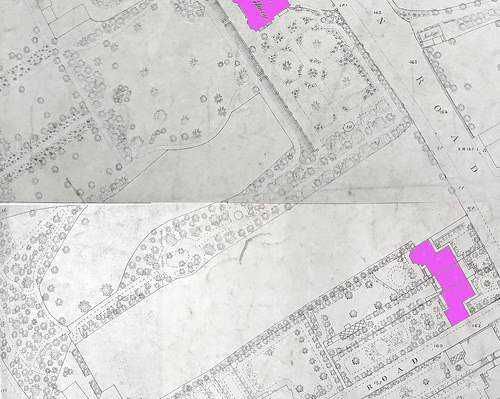
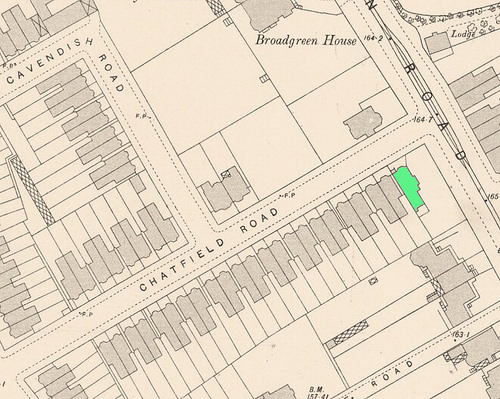
1890s–1900s: Mrs Hooker; Robert Chapman; Charles and Sarah Bull
Most of these new houses had addresses on Chatfield Road, but one — Sydney House, on the southern corner with London Road — also took a London Road address.[8]
Sydney House saw a fair amount of turnover during the first decade of its life. The first recorded occupant was a Mrs Hooker, who only remained for about a year and by 1896 had been replaced by solicitor Robert Chapman. Robert seems to have conducted business from his home at least part of the time, as an advertisement in the 9 January 1896 Evening Standard states that sales particulars for a house on offer near Crystal Palace can be obtained from “Sydney House, Chatfield-road, West Croydon”. However, he also only remained for a short while, and by 1897 had in turn been replaced by Charles and Sarah Bull.[9]
Charles, a retired horse-collar manufacturer, had married Sarah just a handful of years before the couple moved to London Road. When their marriage took place on 8 February 1890 at the parish church of St Luke in the City of London, Charles was a 70-year-old widower and Sarah a 51-year-old spinster. They had just short of a decade together, as Charles died at Sydney House on 2 January 1900. Sarah continued to live at the property for a couple of years after this, taking in lodgers to make ends meet, but moved out by 1903.[10]
1900s: Walter and Hanna Wood
Next to arrive were Walter and Hanna Wood. Born the son of a rice merchant in Liverpool in the 1840s, by the age of 18 Walter was working as a commercial traveller specialising in tea. By 1885 he was living in Westminster, London, with his then-wife Annie.[11]
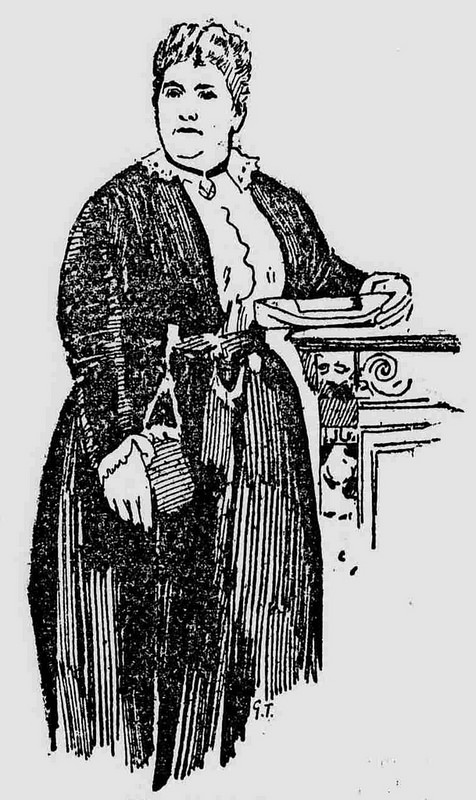
Annie was a prolific inventor, with a mind both practical and imaginative. Inspired by the desire to create “a boat that would be absolutely safe”, she spent five years experimenting with natural rubber to create a buoyant substance which had “all the elasticity of india-rubber, with the additional advantage of being uninflammable and uninjured by salt water” and “endowed with the power of closing up after penetration”. The new material, Woodite, could also “be manufactured very cheaply”.[12]
By 1891, Woodite was in production at a factory on Mitcham Common, and a new house designed by Annie herself was under construction nearby. Woodite Towers, an “ornate Gothic structure in flint”, was “luxurious within and without [...] the beau-ideal of a convenient and comfortable house, commanding on all sides extensive and splendid views of the surrounding country.”[13]
Annie’s other inventions included Whaleite, a combination of Woodite and ground whalebone for use in making items which needed to be both hard-wearing and non-slip, such as horseshoes and cab wheels;[14] a “mechanically propelled” lifeboat which allowed rowers to face forwards instead of backwards;[15] and a “mechanical horse”, which consisted of “a petroleum motor, in the shape of a horse — a horse cut off at the knees, it is true, but having so much the appearance of an ordinary, everyday horse that its appearance on the street, drawing a carriage or cart, is not expected to be in the slightest degree terrifying to the most mettlesone animal”, thus allaying the fears of those who were “expecting that the advent of the new motor-car will cause horses to shy, rear, and plunge upon their first acquaintance with the new carriages”.[16]
Annie died at Woodite Towers on 23 January 1897, and a year and a half later, Walter married Norwegian-born Hanna Simonine Simonsen. By early 1900, Walter and Hanna were living at Beddington Corner, across the common from Walter’s previous home at Woodite Towers, and by 1903 they had moved to Sydney House, London Road. Walter died here on 15 May 1905, at the age of 62, “after a painful illness”, and was buried in Mitcham Road Cemetery. Hanna remained at Sydney House for a short while after Walter’s death, but moved out by 1907.[17]
1900s–1950s: Various private residents, and subdivision of the property
The next half-century saw different residents come and go, with none of them leaving much of an impression on the documentary record. Herbert Haslegrave, Arthur Sercombe, and Edwin E Chad seem to have been the final three heads of household to occupy Sydney House in its entirety, as from 1923 onwards Ward’s directories list multiple simultaneous residents.[18] Indeed, a 1956 planning application makes reference to “all the tenants of No. 151 London Road”, suggesting that by that point it may have become what today would be considered a house in multiple occupation (HMO).[19]
1960s: Redevelopment
The late 1960s saw the final end of both Sydney House and the three buildings originally constructed on Henry Overton’s land over a hundred years previously. By mid-1969, the entire site had been cleared, and construction had begun on a new office block with a garage on the ground floor.[20] The office block occupied the space previously taken up by 145–149 London Road, while the old site of Sydney House became a “Car Waiting area” for customers waiting their turn for the tyre fitting bays in the ground-floor garage.[21]
1970s–1990s: Merritts Speedy Silencer Service, Milex, and Standard Motorists Centres
The ground-floor garage was in occupation by mid-1970, with the space shared between Merritts Speedy Silencer Service and Standard Tyre Co Ltd. Merritts, which specialised in car exhausts, moved out just a couple of years later, at which point Standard Tyre Co became Standard Motorists Centres and began advertising exhaust fitting in addition to tyre fitting. Another car servicing company, Milex, arrived around 1983, but was gone again by 1987.[23]
1990s–present: Central Tyre, Ace Auto Centre, Ace Car Wash, Mek Mester, Enotech Autos, Impact Motor Vehicle Repairs, and Tyre Options
Standard Motorists Centres became Central Tyre in the mid-1990s; it’s not clear whether this was a name change or a takeover by another business, but certainly both the branch at 145 London Road and another branch at 81 Beckenham High Street were under the name of Central Tyre by July 1996. This remained in place for around a decade.[24]
Other businesses followed, including Ace Auto Centre, Ace Car Wash, Mek Mester, and Enotech Autos. However, at the time of writing, the occupants of the ground floor are Tyre Options, at the front, and Impact Motor Vehicle Repairs, round the back with an entrance on Montague Road.[25]
1970s–1980s: The United Association for the Protection of Trade
Meanwhile, tenants were found similarly swiftly for the office space on the floors above, with the first occupant being the United Association for the Protection of Trade, or UAPT.
Founded in 1842 as the London Association for the Protection of Trade, this organisation’s original aim was to formalise an existing practice in which London traders held weekly meetings where they “exchanged views on current questions of commercial interest, asked advice of one another regarding the credit of customers, related experiences with swindlers, etc., etc.”[26]
By the end of the 1950s, a century after its formation, it was handling over 300,000 credit enquiries per year.[27] A mid-1960s merger with another company, Kemp’s Mercantile Offices, led to a new name – the United Association for the Protection of Trade — and heralded a period of reorganisation.[28]
Although it already had a branch in Croydon, UAPT was now seeking new premises both for its London branch and for the bulk of its central management facilities. Its committee met on 11 November 1969 to consider a proposal to take 145–149 London Road for these purposes, and the move began just three months later: “the Accounts Department moved in February, the Collection Department on 12 March 1970, and the London branch moved over the Easter holiday.”[29]
UAPT seems to have moved some of these functions to Zodiac House, just up the road, around 1975, but retained a presence at numbers 145–151 until the mid-1980s, when it transferred all its Croydon operations to Coombe Cross, 2 South End.[30] In 1987, it changed its name from UAPT to UAPT-Infolink and its status from a mutual society to a public company. The new company remained at Coombe Cross until the late 1990s.[31]
1980s–1990s: M J N Ltd
By mid-1986, UAPT’s move to Coombe Cross was complete. The London Road offices remained vacant for a couple of years before being taken over by M J N Ltd, an engineering and building services maintenance firm. This remained until the late 1990s, but was gone by 1999.[32]
1990s–2000s: Rosan & Co and the Croydon Auction Rooms
Next to arrive was Rosan & Co, a firm of property agents and auctioneers. Having been located across the road at number 144 since the early 1970s, the company had now expanded to the point where it needed larger premises. It used the upper floors for offices and conducted its auctions in the basement of the block, which had previously been used as UAPT’s computer room and then as storage space by M J N. Auctions were held fortnightly on Saturdays, with attendances of around 150–200 people in total each time.[33]
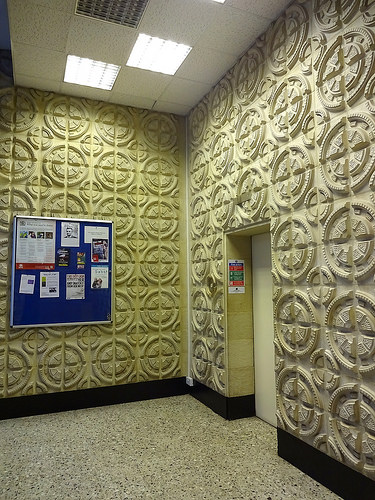
2010–present: Praise House
After the departure of Rosan & Co, both the office accommodation and the basement saw an extended period of vacancy and dereliction. The building was badly vandalised during this time, with the electrical wiring, copper piping, taps, sinks, and even toilet basins all being ripped out, presumably to be sold on for cash.[34]
However, a bright new chapter in the building’s history began in May 2010 with the arrival of Praise House Church, a non-denominational Christian church founded on Brixton Hill six years before. After moving to Streatham and then Thornton Heath, the church took on the lease of the basement and upper floors at 145–151 London Road, and began remedying the years of neglect. Within two years, the building was fully fitted out again with new flooring, wiring, pipes, toilets, and kitchen facilities.
Today, Praise House Church shares its space with several other Christian organisations, and has plans to expand its facilities still further.[35] As Pastor Damian Luke explained to me:
We had always had a vision that whatever building we occupied, we would share the facilities with people who were like-minded and who shared similar aims and objectives as us. Same thing we did when we were in Woodville Road [in Thornton Heath], so we’ve always known that for church organisations finding places of worship and meeting halls and all that was always a problem. [...]
We took over the lease for the ground floor in February 2011 [...] the part occupied by the garage, carwash, and the car tyre places in front. [...] Our intention in 2017 is to get rid of the tyre place downstairs and to convert the whole of the ground floor space as it is now into a decent church meeting hall, like a hall for the community, possibly with a small coffee shop, and have paving outside and a seating area. [..] Where people can come into — and where we can possibly have a crèche facility. [...] We’re currently waiting for the building controller or structural engineers to agree on the final drawing for that work so that we can start what we want to do.
Thanks to: Damian Luke of Praise House Church; Mr Ebo of Tyre Options; Meg Hewitt, for a swift and professional transcription of my interview with Damian; Grace’s Guide; John Wiley & Sons Ltd; the Planning Technical Support Team at Croydon Council; the staff, volunteers, and patrons at the Museum of Croydon; and my beta-readers Alice and bob. Census data and London/Surrey phone books consulted via Ancestry.co.uk. Monetary conversions performed using the Bank of England inflation calculator (prices < £100 given to the nearest penny, prices from £100 to < £100,000 to the nearest pound, prices from £100,000 to < £1 million to the nearest £1,000, prices from £1 million to < £100 million to the nearest £100,000, prices ≥ £100 million to the nearest million).
Footnotes and references
- See my articles on 21 London Road and 145 London Road for more details of the Inclosure and the 1830s land sale. There were at least two auctions of this land, one on 23 May 1835 and another on 21 April 1838 (see Museum of Croydon loose sales particulars BA268 and Harold Williams Volume 1837–1840 Section CXVI, respectively).
Henry’s and Jonathan’s purchases are recorded as handwritten notations on the copy of the sales particulars for the 21 April 1838 auction bound in the Harold Williams volumes at the Museum of Croydon (Volume 1837–1840, Section CXVI). Henry paid £385 (£38,500 in 2015 prices) for a piece of land with a frontage of 121 feet (37 metres), which is pretty much exactly the distance from the middle of Montague Road to the north edge of Praise House as measured using Google Earth. Jonathan paid £400 (£40,000 in 2015 prices) for a piece of land with the same length of frontage, which takes us from the north edge of Henry’s land up to the middle of the modern Chatfield Road.
Further information on Henry Overton can be found in my article on 149 London Road.
Jonathan’s occupation and place of origin are taken from pages 33–34 of Urban Development and Redevelopment in Croydon 1835–1940, Ron Cox, PhD thesis, Leicester, 1970. The references given for this are firstly the particulars of the sale of Broad Green House on 30 May 1848, and secondly the 1851 census. The latter does indeed list Jonathan Barrett as a “Retired Iron & Brass Founder”. I haven’t managed to find anything relevant in the former source, however; both the version in the bound Harold Williams volumes and the loose version (ref CR2676) at the Museum of Croydon are missing the Conditions of Sale, which is where I might expect to find information about previous owners. So it remains unclear where the Streatham connection is proved.
- The 1844 Tithe Award makes no differentiation between this strip of land and the rest of the grounds south of the house, describing them in total as “Lawn & Garden / House, out offices” (the grounds north of the house are listed separately as “Stable, meadow etc”). Ward’s directories list the area between 149 London Road and Broad Green House as “Pasture land” from 1874 (the first edition of these directories) to 1892 inclusive.
- I’ll discuss Broad Green House at greater length in a future article. Some of the new houses built by Jonathan Barrett can be seen at the bottom right of the 1891 plan reproduced here.
- Mary’s date of death is taken from her entry in the National Probate Calendar. The division of Broad Green House into Chatfield House and “Broadgreen [sic] House” can be seen on the 1896 Ordnance Survey map. Chatfield Road appears in Ward’s directories from the 1893 edition onwards (note that data for these directories was generally finalised late the previous year).
See the 1896 map extract reproduced here for evidence of housing along Chatfield Road. Ward’s 1893 directory lists “Building land” and “Two houses building” on the north side of the road, and more “Building land” interspersed by “Eight houses building” and “Four houses building” on the south side of the road. The 1894 edition shows eight houses on the north side and 21 houses (plus two under construction) on the south side.
It might be of interest to make a comparison with Montague Road, which seems to have been constructed by Henry Overton before 1851 (the Museum of Croydon’s Marshall Liddle & Downey index summary of a deed dated 1 March 1858 [index page 49] states that Montague Road was “made by Hy. [Henry] Overton”). This road is mentioned in Gray’s 1851 directory as a side road in the London Road section, but with no mention of houses being on it, while the 1853 edition states that it has “Four New Houses (unfinished) on right-hand side” (i.e. the north side).
- The discontinuities visible on the 1868 map image are because this was pieced together from two different map sheets (and two different photos of the lower map sheet). The 1896 image can be seen in context on the National Library of Scotland website.
Ward’s directories list Sydney House as both an unnumbered London Road property and 1 Chatfield Road in 1894; as 1 Chatfield Road only from 1895 to 1902 inclusive; as both 93 London Road and 1 Chatfield Road from 1903 to 1907 inclusive; and as 93 London Road only from 1908 onwards (with the Chatfield Road listings starting at number 3). Sydney House could possibly have been named after Sydney Edridge, who was one of the developers responsible for all this new housing, but it isn’t clear why he would have decided to do this, nor why he would have chosen to use his first name rather than his family name.
The house on the opposite side of Chatfield Road from Sydney House also had a London Road address. Initially known as Abbotsbury, it took the address of 101 London Road around 1900, and was renumbered to 179 in 1927. Unlike Sydney House, it is absent from the Chatfield Road section of all the editions of Ward’s directories that I’ve checked.
- Ward’s directories list Sydney House, unoccupied, in 1894; Mrs Hooker in 1895; Robert Chapman, solicitor, in 1896; Charles Bull from 1897 to 1900 inclusive; and Mrs Bull in 1901 and 1902. All of these entries are in the Chatfield Road section, and the 1894 entry is duplicated in the London Road section. The advert mentioned in connection with Robert Chapman appears on page 10 of the 9 January 1896 Evening Standard, viewed online via the British Newspaper Archive (requires subscription). Sarah Bull’s first name is taken from the 1901 census.
- Charles’ previous profession and date of death are taken from a notice on the front page of the 10 March 1900 Evening Standard (viewed online at the British Newspaper Archive; requires subscription). Information on Charles and Sarah’s marriage is taken from “London, England, Church of England Marriages and Banns, 1754-1921” (data originally from Church of England Parish Registers, 1754-1921, London Metropolitan Archives), viewed online via Ancestry.co.uk. The 1891 census lists Charles and Sarah, along with their 14-year-old grandson Joseph Hudson, at 23 Moorfields in the City of London; this again states that Charles is a “Horse Collar Maker” and gives his age as 71, putting him at about 77 when he arrived on London Road. The 1901 census lists Sarah as a “Lodging House Keeper” at 1 Chatfield Road, along with lodger Isabella Whitfield and boarders Joseph Hudson and David Roberts; it’s not clear what the distinction between a lodger and a boarder is. The 1911 census places Sarah on Fairholt Road in Stoke Newington, again with two boarders.
Information on Walter’s early life is taken from the 1861 census. The 1881 census shows him and Annie living in East Sheen. He is then listed at 13 Delahay Street, Westminster, in London phone books from the September 1885 edition to the January 1888 edition inclusive; this is definitely the same Walter Wood, as a notice on page 4897 of the 9 September 1887 London Gazette gives this as the address of “Annie Matilda Wood [...] Wife of Walter Wood, of the same place”, and an article on page 2 of the 18 April 1890 Dundee Evening Telegraph (viewed online via the British Newspaper Archive; requires subscription) mentions this as the address of Mrs A M Wood, inventor (see later in main article).
Interestingly, the 1871 census shows Walter as a 28-year-old married visitor in the household of 30-year-old widow Annie M Bartlett, in Hove. As noted in a later footnote, Annie Wood’s full name was Annie Matilda Bartlett Wood, so it seems extremely likely that this was the same person. One wonders what Walter’s wife at the time thought of all this.
- “Woman as an Inventor”, Pall Mall Gazette, 18 May 1888, page 2 (viewed online at the British Newspaper Archive; requires subscription) and “Woodite”, St James’s Gazette, 23 October 1886, page 12 (also viewed online via the British Newspaper Archive). First, third, and fourth quotations taken from the former source; second quotation taken from the latter.
An article on page 6 of the 28 February 1891 Croydon Advertiser mentions “the Woodite Works, Mitcham Common” and “Woodite Towers, a massive mansion now in course of construction and adjoining the Woodite Works, on the road between Tooting and Croydon” (“A Church on Mitcham Common”, viewed online via the British Newspaper Archive; requires subscription — said church was also “generously built and furnished” by Annie). The first quotation describing Woodite Towers is from Eric Montague’s Mitcham Common, page 75, while the second, and the information that the house was “Designed entirely by herself”, is taken from an article published in Hearth and Home, viewable online via the Internet Archive copy of an eBay auction page. However, I haven’t been able to find this article in Hearth and Home itself. The eBay listing states that it was published in 1897, but despite looking through all issues up to the end of April, I can’t find it, and Annie died in January 1897 so it seems unlikely to have been published much after her death.
Mitcham Common gives more details of the Woodite Works in its chapter on “Mitcham Workhouse and the Creameries”. The buildings were originally constructed in the 1780s to provide a workhouse for Mitcham parish, but this became surplus to requirements after Mitcham amalgamated its Poor Law arrangements with other parishes in the 1830s, forming the Croydon Union. The inmates were moved to the Croydon workhouse on Duppas Hill (which was later the first home of Croydon General Hospital), and the Mitcham Common premises handed to the lord of the manor, James Moore. By the mid-1840s, the buildings were in use by William Cribb & Co for the manufacture of “blacking, ink, vinegar, and lucifer matches”, and by the 1850s they were being used by William Hooper to manufacture rubber and related products. The extensions and modifications made by the latter William could well have made the premises more attractive for the Woodite Co Ltd.
By 1903, Woodite Towers had been converted into a factory and renamed Tower Works. During the Second World War, it was used as the headquarters of a Home Guard Company, until it was destroyed in an air raid on the night of 16 April 1941. (However, both factories are shown, apparently intact, on the 1954 Ordnance Survey map of the area.) A photo of the Tower Works c.1904 can be seen via Merton Council’s Photographic Archive. Today the area is occupied by a housing development known as Talbot Close.
- “Woman as an Inventor” (see earlier citation).
- “A Lady’s Inventions”, Dundee Evening Telegraph, 18 April 1890, page 2 (viewed online at the British Newspaper Archive; requires subscription).
- “A Mechanical Horse”, Sheffield Weekly Telegraph, 5 December 1896, page 22 (viewed online via the British Newspaper Archive; requires subscription.
- Annie’s date and place of death are taken from her entry in the National Probate Calendar, which also gives her full name as Annie Matilda Bartlett Wood. Hanna’s place of birth is taken from the 1901 census, and her full name and date of marriage (3 September 1898) are taken from “Surrey, England, Church of England Marriages, 1754-1937” (data originally from Anglican Parish Registers, Surrey History Centre, Woking), viewed online via Ancestry.co.uk. Ward’s directories list Walter at Woodite Towers (or just “Woodite” in 1898 and 1899), Mitcham Common, from 1893 to 1899 inclusive and at Mill Green Lodge, Beddington Corner, in 1900, 1901, and 1902. The 1901 census also shows Walter and Hanna at Mill Green Lodge in the ecclesiastical parish of Beddington St Mary the Virgin. Ward’s directories then list Captain Walter Wood at Sydney House, 93 London Road (later renumbered to 151) in 1903, 1904, and 1905; Mrs Wood at the same address in 1906; and “unoccupied” in 1907. Walter’s date and place of death are taken from his entry in the National Probate Calendar, the quotation about his illness is taken from his death announcement on page 4 of the 20 May 1905 Croydon Advertiser, and his place of burial is taken from the “Cemetery Returns” on page 8 of the same Croydon Advertiser. Hanna survived until 1913, according to her own entry in the National Probate Calendar.
- Ward’s directories list Herbert W G [sic] Haslegrave in 1908, Herbert V W [sic] Haslegrave in 1909 and 1910, Arthur Sercombe from 1911 to 1914 inclusive, “unoccupied” from 1915 to 1920 inclusive, and Edwin E Chad in 1921 and 1922. For the remaining editions up to the final one in 1939, they list between three and five residents for each year, with the full list being G Micklewright, — Janvrin, H Lossack, C T Ross, W Micklewright, F J Webb, C Kempsell, J H Preston, C R Wheatman, A W Ellis, Matthew Whitehead, Mrs Woodhams, Wilfred Brett, G W Martlin, Herbert Sewell, H Turner, F Yarnold, A Havers, Mrs K Loder, and T Lemon. Kent’s 1955 and 1956 directories both list Charles F Brimble and Leslie J Lloyd.
- Planning application reference A1283, viewed on microfiche at Croydon Council ofices. This application, which was granted on 23 October 1956, was in relation to an existing advertisement hoarding between the garden of number 151 and the pavement of London Road; it requested permission to extend this hoarding perpendicularly away from the road to separate number 151’s garden from the forecourt of number 149. The applicant, A Scott’s Poster Service Ltd, stated in a letter that it had been “approached by all the tenants of No. 151 London Road, with a request that the existing hoarding be extended along the boundary wall of 149/151 London Road, in order to secure the return frontage of the garden against trespassers.”
- The 1955 Ordnance Survey map shows 145, 147, and 149 London Road, as well as Sydney House (labelled as 1 Chatfield Road), but all four of these buildings have gone by the 1970 edition. A planning application submitted on 14 April 1969 (viewed on microfiche at Croydon Council offices; ref 69/20/778) states that the current use of the site previously occupied by Sydney House is “Derelict site” with a “Derelict house last occupied circa 1966”; despite this mention of the house as a “current use”, it seems that it had already been pulled down, as the plan included in the application shows its outline as “line of existing house now demolished”. The plan also shows a “development under construction” set back from the road where 145–149 used to be.
- See planning application ref 69/20/1242, granted 4 July 1969.
- Planning application ref 69/20/1242, granted 4 July 1969. This is my sketched copy of the original diagram.
- Phone books list Merritts Speedy Silencer Service Ltd at 145 London Road from the August 1970 Croydon edition to the March 1973 Croydon edition inclusive; some of these phone books describe it as “Mtr Engs” (presumably “Motor Engineers”) and some describe it as “Exhaust Replacements”. Standard Tyre Co is listed under that name from the August 1970 Croydon edition to the July 1974 Croydon edition inclusive, and as Standard Motorists Centres Ltd from the February 1975 North East Surrey edition to the January 1995 Croydon edition inclusive. February 1975 also marks the point at which its phone book entries begin to variously specify “Exhaust”, “Tyre & Exhaust Fitting”, and “Exhaust, Tyre & Spares Depots”. The records of a planning application submitted in July 1971 (ref A6224) include photos taken by a council enforcement officer on 19 May 1971 showing unauthorised signs put up by Standard Tyre Co; these signs advertise batteries, brakes, and tracking an balancing in addition to tyres, but not exhausts.
- Croydon phone books list “Standard Motorists Centres”, “Standard Motorists Centres (S M C)”, or S M C (Standard Motorists Centres)” at 145 London Road and (usually) also 81 Beckenham High Street up to and including January 1995. The July 1996 edition instead has “See Central Tyre” under S M C, and Central Tyre is listed at 145 London Road and 81 Beckenham High Street. The final appearance of Central Tyre is in the 2006–2007 edition.
- Ace Auto Centre is listed in the 2009–10 Croydon phone book. The name “Tyre Options” doesn’t appear on the frontage, but according to Mr Ebo, manager of the business, this is its name; he also told me that at the time of our conversation it had been there for less than a year (on-site interview, 18 November 2016). Other information is from various flyers and personal observation; see for example photo of Ace Car Wash in March 2012 and photo of Impact Motor Vehicle Repairs in November 2016. See also photo of tyre sales in March 2012 and photo of car sales and parking in March 2012. I have a flyer for Enotech Autos from September 2015.
- Information and quotation taken from C McNeil Greig’s history of UAPT, The Growth of Credit Information, p21. The quotation is itself a quotation, of “an old brochure of the Association’s services”.
- The Growth of Credit Information, Table 19.3, page 215. This table gives annual figures for “Enquiries”, which “included enquiries made by way of a post or telephone search”: 344,864 in 1959, 331,649 in 1960, and 381,880 in 1961.
- The Growth of Credit Information, Chapters 20 and 21.
- Information and quotation taken from The Growth of Credit Information, p233. The existing Croydon branch seems likely to have been on the upper floors of 73–77 London Road, as phone books list Kemps [sic] Mercantile Offices there from the August 1965 Croydon edition to the August 1969 Croydon edition inclusive (with neither the London Association for the Protection of Trade nor the United Association for the Protection of Trade appearing anywhere else), and the United Association for the Protection of Trade there from the September 1969 North East Surrey edition to the July 1974 Croydon edition inclusive.
Croydon phone books list UAPT at 145–151 London Road from 1970 to 1985 inclusive. Prior to the February 1975 North East Surrey edition, this includes “Enquiries” as well as “National Credit Register”, but from 1975 onwards, “Enquiries” has moved to number 163 (Zodiac House) while “National Credit Register” remains at 145–151. The 1987 and 1988 editions instead list the company only at Coombe Cross, 2 South End (and, for some reason, in Birmingham). Infolink Ltd is listed at Coombe Cross from 1990 to 1996 inclusive, but is absent from 1998 onwards.
The move to Coombe Cross is described as follows in Chapter 25 of The Growth of Credit Information. UAPT had been considering moving to Redhill, but “the Association’s consulting engineers were of opinion that ‘the electrical and mechanical services and equipment [at the proposed premises] did not meet the normally acceptable standards’. The Association had ‘kept its options open on the property at Coombe Cross’ in Croydon”, and so on 20 September 1985 it signed a lease for that building, with “an option to purchase until 31 March 1986.” A new computer system was installed by the end of 1985, and the move of personnel took place in stages during the first half of 1986.
- Information on name change taken from note at beginning of Index of The Growth of Credit Information; information on status change taken from Peter Clokey, “UAPT comes under the hammer”, Acquisitions Monthly, January 1995, page 64. (There is almost certainly more information on this in The Growth of Credit Information, but I didn’t have time to re-check that source before publishing.) Croydon phone books list Infolink Ltd at Coombe Cross from 1990 to 1996 inclusive, but the company is absent from the 1998 edition onwards.
See previous footnote for date of UAPT move. M J N Ltd were granted planning permission for “Use of first, second and third floors as offices and basement for storage of mechanical equipment” at 145–149 London Road and 2 Montague Road (the latter address being part of the same premises) on 26 May 1988 (ref 88/1442/P). The planning application includes a statement that the building had “recently been vacated by the United Association for the Protection of Trade”. Another application (ref 88/2282/A), for a “High level illuminated sign”, includes a drawing of the proposed sign with the wording “M J N / BUILDING SERVICES MAINTENANCE / M J N MAINTENANCE”.
Croydon phone books list M J N Maintenance, “Bldg Servs Maintce”, at 145 London Road from 1988 to 1998 inclusive (along with M J N Refrigeration, Refrig Engs, from 1990 onwards). In addition, a later planning application by a different company (ref 99/2589/P) includes a report from Croydon Council’s Forward Planning Team which states that “The premises [...] were surveyed as part of the first EM8 sites survey in April 1997. According to our survey information, 145 was occupied by M J N Refrigeration and 147 by Central Tyres.” Before, during, and after this period, Croydon phone books also list M J N (or, from 2001 onwards, M J N Colston) as “Mech Elec Engs” or “Mech Elec Engineers” on Dingwall Road (initially at M J N House and later at 11 Dingwall Road; I don’t know if these two addresses are for the same building), with a storage facility at Redhouse Industrial Estate, Redhouse Road.
- See previous footnote for dates of M J N’s tenure, and my article on 144 London Road for more information on Rosan & Co. Information on the parts of the building used by Rosan & Co and details of the auctions are taken from a planning application granted on 7 June 2000 (ref 99/2589/P); this does however make a point of assuring the planning department that auction attendees “are not all in the rooms at one time, they come and go dependant [sic] on the lots and timing of those lots being sold. On average at any one time approximately 30–40 people at most will be on the premises and usually in the region of 20–30.”
- All information in this section is taken from an interview with Damian Luke, Pastor of Praise House Church (in-person interview conducted at Praise House, 16 January 2017).
- For a list of organisations occupying Praise House as of November 2016, see my photo of the list at the building entrance.
